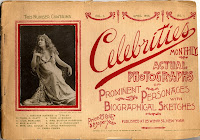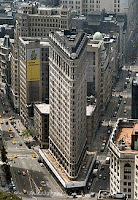As I have continuously stated on this blog, magazines are an important window of American popular culture. No better testimony to that fact is the following, that bears a relationship to my concurrent passion, the health of our thirty-second president, Franklin Delano Roosevelt.
Shortly after Franklin Roosevelt's death on April 12, 1945, and obscure but credible news magazine published a story, in three parts, entitled "The Strange Death of President Roosevelt". It laid out a scenario that Roosevelt's health was not as good as the public had been led to believe, and that he had actually died of cancer.


http://www.scribd.com/doc/12902806/News-Story
The story is constructed in a wildy over the top format and contains some inaccuracies but there is indeed a ring of truth within it. It is clear that the source of the story was Chicago Tribune white house reporter Walter Trohan, who was particularly concerned about the president's health, but, while FDR in office, was unable the violate the strict code imposed by press secretary Stephen Early, forbidding any unauthorized mention of Roosevelt's medical condition (there is even a mention of this in the article).
The similarities between Trohan's article that ran in the Chicago Tribune on April 13th, 1945, rather amazingly overlooked at the time, is further testimony to his anonymous contibution to the magazine article.
www.scribd.com/doc/20368895/Chicago-Trib-April-13-1945
Here is another later Trohan Tribune article, published concurrently with the magazine article.



The book I co-authored with journalist Eric Fettmann, FDR's Deadly Secret, will be released on Tuesday, January 5th. It is the consummation of three years of intense research and lays out the health of Franklin Delano Roosevelt as never before.
It has received excellent reviews (Google or Bing the book title for a long list).
Here is the one that appeared recently in the Boston Globe:
A second opinion on FDR’s condition
By Claude R. Marx
January 2, 2010
FDR’S DEADLY SECRET
By Steven Lomazow, MD, and Eric Fettmann
PublicAffairs, 304 pp., $25.95
Franklin D. Roosevelt's health problems have been so well chronicled that even those with a great interest might have thought there wasn't much to say about it.
Then, along came neurologist Steven Lomazow and journalist Eric Fettmann. “FDR’s Deadly Secret,’’ which is likely to trigger much discussion among physicians and historians, contends that in addition to all his other maladies, Roosevelt suffered from melanoma. They argue that it was cancer that killed him on April 12, 1945, less than three months after he began his fourth term.
According to Lomazow and Fettmann the melanoma started with a lesion above FDR’s left eye and eventually spread to his brain and abdomen. The authors’ diagnosis comes on top of what historians have always acknowledged about FDR’s health: his heart disease, fluctuating blood pressure, and the effects of polio. While some of their evidence is circumstantial, the authors also make use of newly discovered correspondence and some medical records that hadn’t previously received much attention.
After examining the video of a speech that Roosevelt gave to Congress on March 1, 1945, reporting on the Yalta Conference (and comparing it to the manuscript that FDR used), the authors reached a startling conclusion. FDR’s halting delivery and inability to follow the text was caused by an inability to find the margin of the page on which his speech was given. From this evidence, they conclude, that the president “was suffering from a neurological condition called left hemianopia, characteristic of a specific focal dysfunction in the right posterior portion of the brain.’’ And they further hypothesize that the melanoma - which they say had been malignant for four or five years - had metastasized to his brain.
To the non-medical expert, the authors make a strong case. However, the fact that by necessity they are relying on circumstantial evidence will cause some of the debate on this subject to continue.
While FDR’s performance shocked many people, including some of his closest friends and allies, it followed the pattern of his behavior at Yalta. Many historians have criticized the substance of the agreement at Yalta and contend that FDR was misled in part because he didn’t have full control over his mental faculties. The authors cite the observations of other attendees that Roosevelt looked ill and acted disengaged.
“To a doctor’s eye, the President appears a sick man. He has all the symptoms of the hardening arteries of the brain in an advanced stage, so that I give him only a few months to live,’’ Winston Churchill’s physician Charles McMoran Wilson (Lord Moran) wrote in his diary.
A year earlier, several prominent American physicians expressed similar concerns and made them known to Roosevelt and his aides.
Lomazow and Fettmann note that renowned Boston surgeon Frank Lahey had, after examining him, privately counseled FDR that he wouldn’t live through a fourth term. Lahey never made his reservations known to the public and the authors contend that he and FDR’s personal physician Admiral Ross McIntire deceived the public and worked to squelch any rumors that the president had cancer. The authors also quote several other physicians who reportedly told Lahey that FDR had cancer.
The authors note that while in 1944 FDR’s heart problems were becoming widely known, “[C]ancer, on the other hand, remained FDR’s deadly secret, not even hinted at and certainly never to be acknowledged in writing.’’
The authors present their material in an engaging, though not sensationalistic manner. As a result, “FDR’s Deadly Secret’’ will find a wide following among those interested in one of American history’s most compelling medical mysteries.
Claude R. Marx is an award-winning journalist who has written extensively on history and politics.
I hope you enjoy reading our book as much as we have writing it.
































